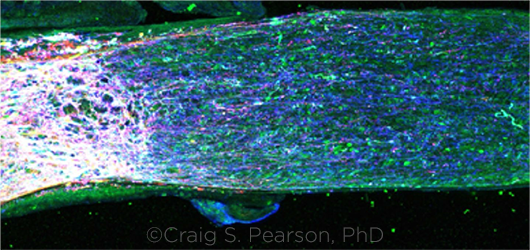Download PDF
New insight into axon regeneration could help develop new glaucoma therapies. University of Cambridge researchers have found that protrudin—an important endoplasmic reticulum protein—strongly promotes axon regeneration and neuroprotection in the retina and optic nerve of rodents.1
“Adult mature nerve cells don’t normally regrow after injury,” said lead author Veselina Petrova, PhD—and successful regeneration of the central nervous system has proved to be an elusive research goal. But the U.K. team discovered that the overexpression of protrudin in cultured rat cortical neurons enhanced axon regeneration after optic nerve crush with a laser.
According to Dr. Petrova, this was one of the strongest promoters of axon regeneration that they had seen in a dish, inspiring them to study the protein in the optic nerve.
 |
RESULTS. Optic nerve regeneration with enhanced protrudin expression two weeks after optic nerve crush (on the left). Green represents protrudin-positive nerve fibers, blue represents newly regenerating axons, and red represents all axons.
|
Regeneration. To assess the protein’s effect in an animal, the researchers intravitreally injected mice with a gene therapy that elevated the level of protrudin expression. Two weeks after the injection, the researchers performed an optic nerve crush procedure—and two weeks after that, they found that 52% of retinal ganglion cells (RGCs) had survived in the animals with active (phosphomimetic) protrudin, compared with 28% of RGCs in control animals. Protrudin also engendered robust optic nerve regeneration: Active protein induced over 630 regenerating axons to extend as far as 3.5 mm from the injury site, compared with 44 axons with limited regeneration in control animals.
The level of regeneration was surprising, Dr. Petrova said. “It basically equaled some of the best treatments in the field and definitely is one of the best we have seen in our lab.”
Neuroprotection. In a second experiment using the rat acute retinal explant model, the researchers found that protrudin may also confer protection. While control retinal explants lost more than half of their RGCs over three days, retinas that received protrudin two weeks earlier lost none. “I think people are really looking for [this] in the field of ophthalmology right now to protect the cells that are normally dying, especially in conditions such as glaucoma,” said Dr. Petrova. “We think that our preclinical model is very relevant to finding neuroprotective therapies for glaucoma.”
Future directions. Current research suggests that protrudin stimulates axon regeneration by shifting endosomes and endoplasmic reticulum into the distal part of injured axons. Moving forward, the Cambridge group will parse the molecular mechanism behind regeneration and neuroprotection, particularly in humans, Dr. Petrova said. They are already studying protrudin in human retinal explants in a collaboration with coauthor Keith Martin, MD, at the Centre for Eye Research Australia and the University of Melbourne.
“Of course, we have to do all the necessary testing for whether our gene therapy actually works in human tissues, whether it is safe, whether it can restore some visual function, what other side effects could there be, and so on,” Dr. Petrova said. “But we think it is a good step forward to have identified a new mechanism that potentially protects retinal neurons from dying as well as helping them to regenerate.”
—Kanaga Rajan, PhD
___________________________
1 Petrova V et al. Nat Commun. 2020;11(1):5614.
___________________________
Relevant financial disclosures—Dr. Petrova: None.
For full disclosures and the disclosure key, see below.
Full Financial Disclosures
Dr. Apte EdenRoc Life Sciences: O; Genentech: C; Iveric bio: O; Liberty Biosecurity: C,O; Merck: C; Metro Biotech International: O; Metro International: O,P; Mylan: C; Novartis/Alcon: C; Ribomic: C.
Dr. Lee None.
Dr. Petrova None.
Dr. Woo Abbvie: L; Allergan: L; Alteogen: C,S; Bayer: L; Curacle: C,S; Novartis/Alcon: C,L,S; Novelty Nobility: C,S; Panolos Bioscience: C; Philophos: C; Retimark: O; Samsung Bioepis: C,S; SCAI Therapeutics: L.; Taejoon: L.
Disclosure Category
|
Code
|
Description
|
| Consultant/Advisor |
C |
Consultant fee, paid advisory boards, or fees for attending a meeting. |
| Employee |
E |
Employed by a commercial company. |
| Speakers bureau |
L |
Lecture fees or honoraria, travel fees or reimbursements when speaking at the invitation of a commercial company. |
| Equity owner |
O |
Equity ownership/stock options in publicly or privately traded firms, excluding mutual funds. |
| Patents/Royalty |
P |
Patents and/or royalties for intellectual property. |
| Grant support |
S |
Grant support or other financial support to the investigator from all sources, including research support from government agencies (e.g., NIH), foundations, device manufacturers, and/or pharmaceutical companies. |
|
More from this month’s News in Review